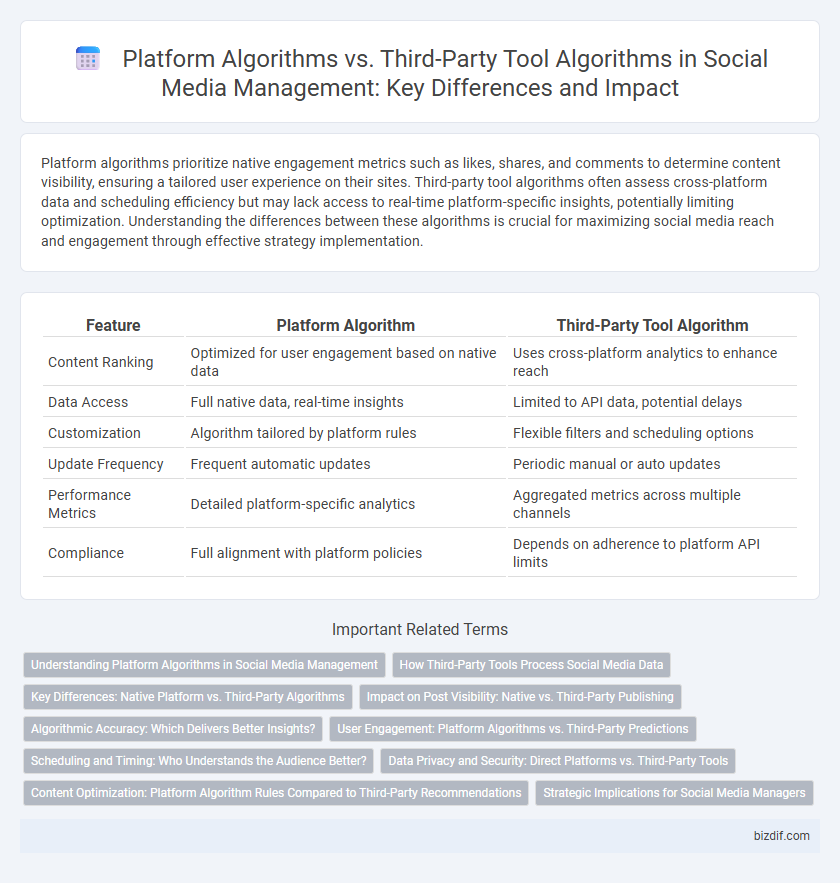Platform algorithms prioritize native engagement metrics such as likes, shares, and comments to determine content visibility, ensuring a tailored user experience on their sites. Third-party tool algorithms often assess cross-platform data and scheduling efficiency but may lack access to real-time platform-specific insights, potentially limiting optimization. Understanding the differences between these algorithms is crucial for maximizing social media reach and engagement through effective strategy implementation.
Table of Comparison
| Feature | Platform Algorithm | Third-Party Tool Algorithm |
|---|---|---|
| Content Ranking | Optimized for user engagement based on native data | Uses cross-platform analytics to enhance reach |
| Data Access | Full native data, real-time insights | Limited to API data, potential delays |
| Customization | Algorithm tailored by platform rules | Flexible filters and scheduling options |
| Update Frequency | Frequent automatic updates | Periodic manual or auto updates |
| Performance Metrics | Detailed platform-specific analytics | Aggregated metrics across multiple channels |
| Compliance | Full alignment with platform policies | Depends on adherence to platform API limits |
Understanding Platform Algorithms in Social Media Management
Platform algorithms prioritize user engagement metrics such as likes, comments, shares, and watch time to determine content visibility, making native tools more aligned with platform-specific ranking factors. Third-party tools often rely on generalized metrics and automation, which may not fully capture or adapt to real-time algorithm updates, potentially reducing content reach and effectiveness. Mastering the nuances of each platform's algorithm enables social media managers to optimize publishing schedules, content formats, and audience targeting to maximize organic growth and campaign success.
How Third-Party Tools Process Social Media Data
Third-party tools process social media data by aggregating metrics from multiple platforms using their proprietary algorithms, which often prioritize user engagement patterns, content type, and posting frequency. These algorithms analyze data differently than native platform algorithms, emphasizing cross-platform trends, competitor analysis, and scheduling optimization to enhance overall social media strategy. Consequently, third-party tools offer insights and automation that complement but do not replicate platform-specific algorithm behaviors.
Key Differences: Native Platform vs. Third-Party Algorithms
Native platform algorithms prioritize user engagement metrics and platform-specific behaviors to optimize content visibility, leveraging proprietary data and real-time interactions. Third-party tool algorithms often depend on aggregated data and generalized patterns across multiple platforms, which may result in less precise targeting and delayed adaptation to algorithm changes. Understanding these key differences is crucial for maximizing reach and engagement in social media management strategies.
Impact on Post Visibility: Native vs. Third-Party Publishing
Native platform algorithms prioritize posts based on real-time user engagement metrics and proprietary data signals that third-party tools often cannot fully replicate. Third-party publishing tools risk reduced post visibility due to delayed publishing times and limited access to platform-specific algorithmic preferences. Leveraging native publishing ensures alignment with platform updates, maximizing reach and algorithmic favorability.
Algorithmic Accuracy: Which Delivers Better Insights?
Platform algorithms leverage native data integration and user behavior signals to provide highly accurate insights tailored to specific social media environments. In contrast, third-party tool algorithms rely on aggregated data from multiple sources, which may introduce discrepancies and limit real-time responsiveness. Evaluating algorithmic accuracy reveals that native platform algorithms often deliver more precise and actionable analytics for social media management.
User Engagement: Platform Algorithms vs. Third-Party Predictions
Platform algorithms prioritize real-time user engagement metrics such as likes, comments, shares, and watch time to boost content visibility within native feeds. In contrast, third-party tool algorithms rely on predictive analytics and historical data trends to forecast user interaction, often lacking immediate adaptation to platform-specific behavioral shifts. Understanding these differences is crucial for optimizing content strategies that maximize authentic audience engagement across social media channels.
Scheduling and Timing: Who Understands the Audience Better?
Platform algorithms leverage native data insights to optimize post timing based on real-time user behavior and engagement patterns, ensuring content reaches the most active audience segments. Third-party tool algorithms rely on aggregated data and historical trends but may lack the granular, platform-specific signals that drive precise scheduling. Effective social media management prioritizes native platform analytics for timing strategies to maximize audience reach and interaction.
Data Privacy and Security: Direct Platforms vs. Third-Party Tools
Direct social media platforms implement proprietary algorithms designed to ensure robust data privacy and security by maintaining user data within their controlled environments. Third-party tools, while offering enhanced functionality, often require access to sensitive user information, increasing potential vulnerabilities and compliance risks with regulations like GDPR or CCPA. Evaluating the trade-offs between direct platform algorithms and third-party integrations is critical for safeguarding data integrity and maintaining user trust in social media management.
Content Optimization: Platform Algorithm Rules Compared to Third-Party Recommendations
Platform algorithms prioritize content engagement metrics such as likes, shares, comments, and watch time to optimize visibility, favoring native content formats and timely posting schedules. Third-party tools recommend optimization strategies based on aggregated data analysis, including keyword usage, hashtag trends, and posting frequency across multiple platforms to enhance reach and audience targeting. Understanding the distinct focus areas of platform-specific algorithms versus third-party tool algorithms is crucial for effective social media content optimization and maximizing organic growth.
Strategic Implications for Social Media Managers
Platform algorithms prioritize native engagement metrics and real-time user behavior, dictating content visibility and reach patterns that evolve frequently. Third-party tool algorithms aggregate data across multiple platforms, providing broader analytics but may lag in adapting to platform-specific changes. Social media managers must strategically balance native algorithm optimization with insights from third-party tools to maximize content performance and audience growth.
platform algorithm vs third-party tool algorithm Infographic

 bizdif.com
bizdif.com